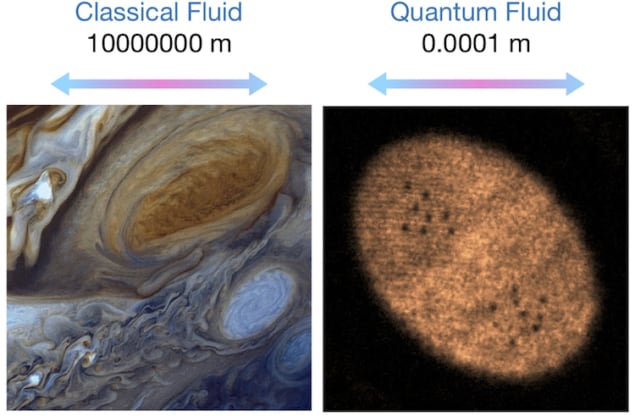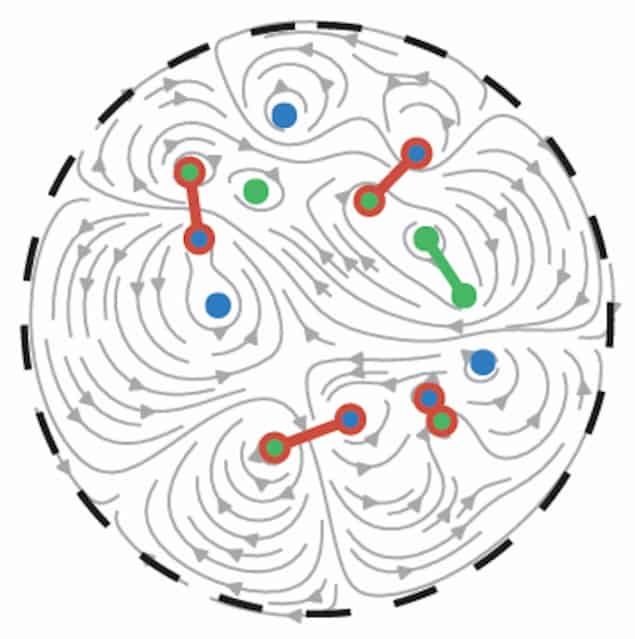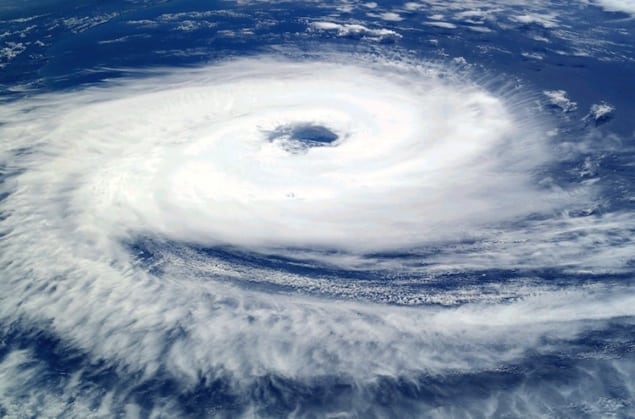
Turbulence is a common phenomenon in nature and is also important for many industrial processes. However, the way in which turbulence arises and then sustains itself is still not completely understood. Indeed, Richard Feynman once described turbulence as the last great unsolved problem of classical physics.
Researchers are making real progress, however, by studying turbulence in 2D fluid flow. In a classical fluid, such as water or air, flow can be described by a dimensionless number known as the Reynolds number, which expresses the ratio of inertial and viscous forces in the fluid. A fluid flowing smoothly becomes turbulent once this number becomes sufficiently large.
The situation is different in 2D fluids, however, because turbulence acquires new features, such as the formation of large-scale vortex structures (or circulation of the fluid) that are like tiny cyclones. This means that a system that is initially chaotic will become more ordered and structured as increasing amounts of energy are supplied to it, which is counterintuitive since we would expect the opposite to happen. Such vortices have been seen in systems ranging from soap films to atmospheric flow on planets (the best-known example being Jupiter’s Great Red Spot).
When I meet God, I am going to ask him two questions: Why relativity? And why turbulence? I really believe he will have an answer for the first. Werner Heisenberg
Onsager’s statistical model
70 years ago, physicist Lars Onsager proposed a statistical model based on point vortices (individual vortices with quantized unit circulation) to explain this behaviour. He showed that vortices that rotate in the same direction (clockwise or anticlockwise) tend to cluster as more energy is put into the system. One of the more interesting aspects of Onsager’s work is that the statistical distribution of these vortices is characterized by absolute negative temperature states (that is, those that are below absolute zero), which correspond to low entropy (more ordered) states. This behaviour is the opposite to most normal systems in which increasing the energy decreases the order (and increases the entropy).
Two independent research groups in Australia have now confirmed Onsager’s statistical model in experiments for the first time in quantum fluids known as superfluids.

What is a superfluid?
A team led by Tyler Neely from the ARC Centre of Excellence for Engineered Quantum Systems (EQUS) at the University of Queensland created its superfluid (a Bose-Einstein condensate) by cooling a gas of rubidium-87 atoms down to nearly absolute zero and trapping it in the focus of laser beams. “We shape the laser beam using digital micromirror devices, a technology that is usually found in video projectors,” explains Neely. “The superfluid then takes on the shape of the laser beam. Using this control, we first create a ‘tank’ of superfluid and then produce ‘paddles’ that we use to stir vortices into the superfluid.

Long lasting vortex clusters
“Our technique isn’t actually much different than stirring a spoon through your coffee, except that we can do this with light and at such a small, micron scale.”
Interestingly, the absolute negative temperature vortex clusters last for a very long time – around 10 seconds. “We were not necessarily expecting this since these vortices can potentially couple to other excitations in the superfluid, dissipating their energy,” says Neely.
Indeed, absolute negative temperature states are sometimes described as being “hotter than hot” since they want to give up their energy to a normal system at positive temperature.“Our experiments show that vortices are relatively isolated from other excitations, however. This means that such superfluids can retain high vortex energies, making them ideal systems in which to study 2D vortex dynamics.”
Meanwhile, researchers led by Kristian Helmerson at Monash University injected point-like vortices into a uniform planar superfluid, also a Bose-Einstein condensate made of rubidium-87 atoms, by dragging a grid of elliptical obstacles formed by an array of laser beams through the atomic cloud.
Towards more clustered, high energy flow states
Helmerson’s team then observed how the resulting states evolve by identifying the sign and location of each vortex in their superfluid. “This technique allows us to directly measure the distribution of the vortices and calculate their temperature, just as Onsager did,” says group member Shaun Johnstone. “We find that this temperature increases, through to negative absolute temperatures, as the flow field increases in energy – just as Onsager described.”
The researchers also saw that initially randomly distributed vortices tend to evolve towards a distribution of vortices corresponding to more clustered, high-energy flow states, thanks to vortex-antivortex annihilation.

The techniques employed in both studies could come in useful for investigating other systems that can be described with Onsager’s model of point vortices. These include helium films, nonlinear optical materials, fermion superfluids and plasmas. From a broader perspective, the results obtained thus far offer some important insights into emerging turbulent phenomena and a better understanding of the non-equilibrium behaviour of interacting quantum systems.
Studying far from equilibrium systems and vortex temperatures
“In our experiments, we essentially created a high energy clustered vortex state that is near equilibrium (at negative temperatures) and observed its very slow decay,” Neely tells Physics World. “The next step in our work will be to initialize arrangements of clusters that are far from equilibrium and then observe how they subsequently relax to a negative temperature state. This is an example of a strongly out-of-equilibrium system – such as what characterises turbulence.”

Raindrop formation in turbulent clouds is observed at long last
Helmerson’s team, for its part, says that it is now looking for stronger signs of the dynamic clustering of vortices, which will mean generating greater numbers of vortices. “We are also studying the temperatures of the vortices in more detail, and are, for example, looking for heat transfer when a hot vortex arrangement and a cold vortex arrangement are generated on opposite sides of a BEC,” Helmerson tells Physics World. “We will also investigate the transition to vortex clustering when we input continuous energy.”
Full details of both Neely and team’s and Helmerson and colleagues’ research projects are reported in Science.



